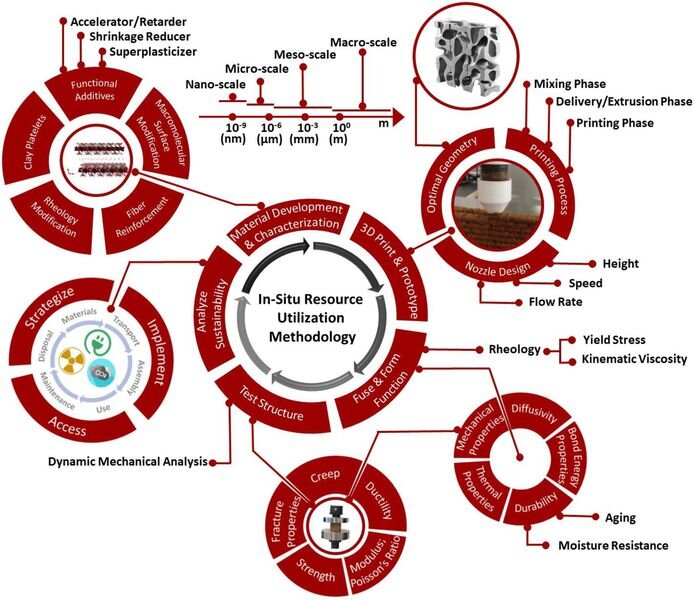![How to create a 3D printing process using local materials [Source: Frontiers in Materials]](https://fabbaloo.com/wp-content/uploads/2020/05/image-asset_img_5eb067e8f238f.jpg)
How to create a 3D printing process using local materials [Source: Frontiers in Materials]
I’m reading a paper from Texas A&M University researchers that discusses the notion of using in-situ materials for additive manufacturing of buildings.
When you learn more about this concept, I’m sure you’ll agree with me that it is a sweeping change in philosophy regarding construction in general, rather than simply a new material for construction 3D printers.
Current State Of Construction 3D Printers
There are several — but not many — companies producing construction 3D printers. These tend to be CNC-enabled concrete extrusion systems. Some are scaled-up versions of the venerable Cartesian XYZ motion systems, or extruders attached to mobile robotic arms, or even a combination of both.
The common link between them is they use concrete as the building material.
There is one venture I’m aware of, Italy-based WASP, which developed a method of 3D printing simple clay structures. Their goal appears to be to easily produce basic housing in third world countries, and not to pursue the large-scale general construction market.
Concrete As Construction Material
Concrete has revolutionized the world of construction over many years. By combining it with reinforcing steel, builders were then able to design and construct massive buildings and structures the likes of which the world had never seen. Much of our cities’ visible structure is made from concrete in this fashion.
But many problems with concrete have arisen in recent years.
A major problem that has been ignored until the last few years is that the production of concrete material releases a significant amount of greenhouse gas.
There’s even a Wikipedia page describing the environmental impact of concrete. There, it states:
“The cement industry is one of the two largest producers of carbon dioxide, creating up to 8% of worldwide man-made emissions of this gas, of which 50% is from the chemical process and 40% from burning fuel. The CO2 produced for the manufacture of structural concrete (using ~14% cement) is estimated at 410 kg/m3 (~180 kg/tonne @ density of 2.3 g/cm3) (reduced to 290 kg/m3 with 30% fly ash replacement of cement). The CO2 emission from the concrete production is directly proportional to the cement content used in the concrete mix; 900 kg of CO2 are emitted for the fabrication of every ton of cement, accounting for 88% of the emissions associated with the average concrete mix.”
Even worse, this cement must be physically transported from the manufacturing site to the building site, which could be quite distant. Imagine the tonnage of cement and/or concrete that must be transported by large CO2-producing trucks for a large building project.
These effects will become much more noticed in the near future, and solutions must be devised.
One of the solutions would be to use on-site materials, and that’s what the researchers sought to examine. Such a solution could be not only less environmentally damaging, but also less expensive by reducing the material and transport costs. Finally, when the building expires, its material can simply be returned to the local environment.
In reality, this is not a new concept; bricks have long been made from local materials, and perhaps it’s time to go back to where we started, material-wise.
In-Situ 3D Printed Buildings
The research paper explores this notion in quite a bit of depth. Their proposal is that rather than using traditional concrete and incurring the environmental damages described above, to instead use local material on site or nearby as building material.
This is a broadly ambitious goal that is actually quite a complex problem. It’s easy to say “build it with dirt”, but the fact is that “dirt” varies wildly depending on where you happen to be in the world. Thus there would have to be many different types of in-situ building materials that vary by region.
The researchers developed a type of unified method for developing a specific construction 3D printing process, as seen at top. The process involves a great many steps, some of which are complex. If you look through the steps of this process, you will see that all aspects are covered and an in-situ material construction 3D printing process developed from it could very well be successful.
To that end the researchers explored the use of several different building material combinations, including geopolymer cement, burlewash series clay and more. There are countless combinations to produce usable materials, and we’re only at the beginning.
If you’re interested in the future of construction 3D printing, you might want to have a read through this fascinating paper.

